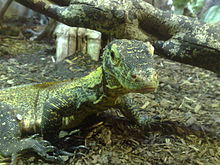Scientific name: Varanus komodoensis Komodo dragons are the world's heaviest living lizards. They can grow to a length of 10 feet (over 3 meters), with an average length of 8 feet (2.5 meters) and weight of 200 lbs (91 kg.). Females are usually under 8 feet and weigh about 150 lbs. (68 kg.). The Komodo dragon's keen sense of smell, if aided by favorable wind, enables it to seek out carrion. up to 5 miles (8.5 kilometers) away. Despite its size, the Komodo is fast moving and agile. They can climb trees and like all monitor lizards they are good swimmers.Their teeth are laterally compressed with serrated edges, resembling those of flesh-eating sharks. They have about 60 teeth that they replace frequently and are positioned to cut out chunks of its prey. The highly flexible skull allows it to swallow large pieces of its food. The Komodos mouth is full of virulent bacteria and even if its prey survives the original attack, it will die of infection later. In addition, recent research3,4 suggests that the Komodos have a venom gland which is more important in disabling their prey. Young dragons up to 29 inches (.75 meters) live in trees and eat insects, birds, eggs, small mammals and other reptiles. They will descend from the tree for carrion. The distribution of Komodo dragons is restricted to the Lesser Sunda Islands of Rinca, Komodo, Flores and the smaller islands of Gili, Montang and Padar. Padar does not have a permanent population. The total range is less than 1,000 sq. km. Komodo National Park makes up all islands except Flores. The natural habitat of Komodo dragons is extremely harsh by human standards. These arid volcanic islands have steep slopes and little available water most of the year. A short monsoon season often produces local flooding. The average annual temperature at sea level on Komodo island is 80F. degrees. Dragons are most abundant in the lower arid forest and savanna. Outsiders found out about the Komodo dragons after WW1 when a report came from a downed aircraft and the surviving pilot swam to Komodo Island.
Common name: Ora, Komodo dragon, buaja darat (land crocodile)
PHYSICAL CHARACTERISTICS:

DISTRIBUTION and HABITAT:
BEHAVIOR:
An eyewitness account revealed that a 101 lb (46 kg.) dragon ate a 90 lb. (41 kg.) pig in 20 minutes. As a comparison, a 100 lb. person would have to eat 320 quarter pound hamburgers in less than 20 minutes to keep up with the dragon.The Komodo is carnivorous and cannibalistic and it has a prodigious appetite. They regularly kill prey as large as pigs and small deer, and have been known to bring down an adult water buffalo. They are opportunistic feeders and will eat anything they can overpower including small dragons and small or injured humans (dragons make up to 10% of their diet).In the zoo, the Komodo dragons are fed previously frozen rats.

REPRODUCTION and GROWTH:
The life expectancy of a Komodo is between 20 to 40 years. As noted above, Komodo dragons are generally solitary animals, except during the breeding season.
The male Komodo dragon presses his snout to the female's body, and flicks her with his long, forked tongue to obtain chemical information about her receptivity. He then scratches her back with his long claws, making a ratchet-like noise. If unreceptive, she raises and inflates her neck and hisses loudly.
The female wild dragons will utilize the nest mound of a brush turkey in which she will lay a clutch of up to 30 eggs. Hatchlings are about 15 inches (40 centimeters) and weigh 3.5 ounces (100 g.).
Juveniles are multi-hued, (yellow, green, brown and gray); with a speckled and banded skin. Adult colors vary from earthen red to slate gray and black.
STATUS:
Endangered: The largest threat is volcanic activity, fire and subsequent loss of its prey base. Currently habitat alteration , poaching of prey species and tourism may have the most pronounced effect. Commercial trade in specimens or skins is illegal under the Convention on International Trade in Endangered Species (CITES).
Wild Population: 3,000 to 5,000.
Honolulu Zoo: Doc (M) and T.W. (F), arrived at the Honolulu Zoo in 1993. Our dragons were from the first group hatched by the breeding program at the National Zoo in Washington, D.C.



Parthenogenesis:
Ecology
The Komodo dragon prefers hot and dry places, and typically lives in dry open grassland, savanna, and tropical forest at low elevations. As an
ectotherm, it is most active in the day, although it exhibits some nocturnal activity. Komodo dragons are largely solitary, coming together only to breed and eat. They are capable of running rapidly in brief sprints up to 20 kilometres per hour (12.4 mph), diving up to 4.5 metres (15 ft), and climbing trees proficiently when young through use of their strong claws.To catch prey that is out of reach, the Komodo dragon may stand on its hind legs and use its tail as a support. As the Komodo dragon matures, its claws are used primarily as weapons, as its great size makes climbing impractical.For shelter, the Komodo dragon digs holes that can measure from 1–3 metres (3–10 ft) wide with its powerful forelimbs and claws. Because of its large size and habit of sleeping in these burrows, it is able to conserve body heat throughout the night and minimize its basking period the morning after. The Komodo dragon typically hunts in the afternoon, but stays in the shade during the hottest part of the day. These special resting places, usually located on ridges with a cool sea breeze, are marked with droppings and are cleared of vegetation. They also serve as a strategic location from which to ambush deer





 4:07 AM
4:07 AM
 infosite
infosite



 Posted in:
Posted in: 




0 comments:
Post a Comment